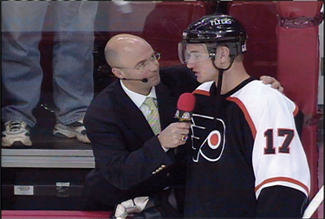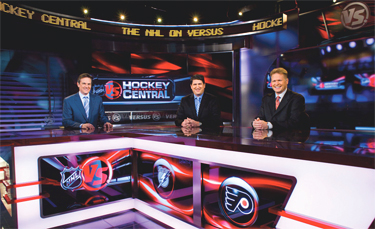Transcending Borders

NHL on NBC Inside the Glass reporter Pierre McGuire interviews Philadelphia Flyers’ center Jeff Carter.
TORONTO
NHL hockey is a passion for many Americans, but for Canadians, it is a religion. During the still-revered 1972 Canada-USSR hockey series, Canadian schools were closed to let kids watch the games on TV.
In the United States, NHL games are broadcast by NBC and transmitted on cable by Versus. In Canada, CBC-TV holds the broadcast rights, while TSN (The Sports Network) handles cable. This adds up to four networks covering one sport in HD; each in their own particular way.
NBC: HOCKEY, UNVARNISHED
"The NHL on NBC Game of the Week" has aired on NBC since the 2005/2006 season and is seen weekly on Sunday afternoons, from a number of NHL game locations. The video is produced in HD and 5.1 audio using NBC's own mobile production truck.
Unlike other networks, NBC's NHL coverage puts hockey first and foremost—with no glitz, razzle-dazzle, or glowing pucks. "The NBC Sports' produc-tion philosophy is to elevate the event, to provide a pure and uncluttered broadcast," said NBC hockey producer Carlos DeMolina. "Nothing is bigger than the game itself."
NBC leases its HD production truck from F&F Productions, out of Clearwater, Fla. Equipment includes Ikegami 79EC HD cameras with Fujinon stabi-lized lenses; Grass Valley Kalypso HD production switcher with Abekas DVeous dual twin DVE and EVS XT2 Spot box; and a Calrec Alpha digital audio console.
The production team is comprised of NBC staffers at the producer, director, AD, graphics, AP, and Tape AP positions; plus engineers manning TD, audio, graphics, and two tape machines stations. "The rest of the crew is made up of local engineers," DeMolina noted. "We travel as a team on Saturday morning, have a setup day at the truck Saturday afternoon, a production meeting Sunday morning and do the game Sunday afternoon. All arenas are wired for TV broadcasts on a regular basis."
For his part, DeMolina is delighted that the NHL on NBC is being produced in HD/5.1 audio. "HD has probably helped hockey more than any other sport with the ability to see more of the ice and more plays developing," he said. "Microphones on the glass have allowed the viewer to feel closer to the game and hear the magical sounds of skates, sticks and pucks."
As for future advances such as 3DTV? Don't expect NBC to jump on it, unless there is a proven improvement in how it covers the game. "At NBC Sports, we don't use technology for technology's sake," said DeMolina. "We only use it to enhance the broadcast, not get in its way."
VERSUS: SUPER SERVE ME
Versus, which has also been carrying NHL hockey since 2005, offers two regular season games a week, "plus wall-to-wall coverage for each round of the Stan-ley Cup Playoffs [double and triple-headers on most nights] as well as Games 3 and 4 of the Stanley Cup Final," said Leon Schweir, Versus' senior vice president of production and executive producer. Schwair's goal is "to 'super-serve' our viewers with the most in-depth and all-encompassing coverage of the 'NHL on Ver-sus.'"
Versus covers its NHL games using a number of NEP HD production trailers nationwide. The production team typically numbers about 30; all of whom "are sea-soned experts in NHL production," Schweir said. "The cameramen are a core group of people that travel from game to game." Depending on the NEP trailer, they shoot using Ikegami HDK-79EC and HDK; Sony 900, 910, 930, 950, 1000, 1500 (fiber and triax); and Thomson 6000 and 8000 (triax) cameras.
"The stadiums are pre-wired for TV and the signal is sent by fiber, not satellite, to Stamford, Conn. to integrate studio components and then to Comcast Media Center in Denver," he noted. The broadcasts are anchored by Bill Patrick and analysts Brian Engblom and Keith Jones in the Versus Hockey Central studio. Besides the games, Versus' NHL games are packed with analysis, debate and player features.

(L to R) Hockey Central hosts on the Versus Network include Bill Patrick, Keith Jones and Brian Engblom. For its efforts, Versus is getting solid ratings. The first NHL on Versus was "the most-watched opening night in network history with 832,781 total viewers," said Schweir. "Additionally, the network earned its highest-rated NHL regular season game ever on Oct. 27 with a match-up featuring the Capi-tals and Flyers."
THE GREAT WHITE NORTH
Canada is devoted to hockey; both through its long-running "Hockey Night in Canada" (HNIC) Saturday evening broadcasts on CBC-TV, and TSN's "NHL on TSN" on cable TV.
"Hockey Night in Canada"'s emphasis is on "storytelling," said Executive Producer Sherali Najak. Using isolation cameras, player interviews, and "Coach's Corner," featuring legendary former Bruins coach Don Cherry, "we are trying to tell why things happen." This ongoing narrative approach plays well in Canada, where devoted fans follow their favorite players and teams for years at a time.
HNIC's broadcasts are shot on location using a core CBC team and the corporation's own production trailers. Sony HD cameras (900, 1000, 1500); Grass Valley and Sony video switchers; and audio boards made by Calrec, SSL and Yamaha are commonly used in these units.
Over at "NHL on TSN," the goal is to provide insight, according to Paul Graham, TSN's executive producer of live events. To do this, TSN sends one of its two on-air announcers out of the booth during games, to take up residence between the team benches. It also uses isolation cameras to track featured players, so that viewers can assess their overall play during the game. TSN also prides itself on providing in-depth analysis between periods: "We want our viewers to feel that they must watch the intermission shows," Graham said.
TSN shoots using HD production trucks leased through its sister company, Toronto's Dome Productions. Dome's trucks collectively employ Ikegami, Sony and Thomson HD cameras; Grass Valley switchers; and audio consoles from Calrec and Soundcraft.
Get the TV Tech Newsletter
The professional video industry's #1 source for news, trends and product and tech information. Sign up below.
James Careless is an award-winning journalist who has written for TV Technology since the 1990s. He has covered HDTV from the days of the six competing HDTV formats that led to the 1993 Grand Alliance, and onwards through ATSC 3.0 and OTT. He also writes for Radio World, along with other publications in aerospace, defense, public safety, streaming media, plus the amusement park industry for something different.

